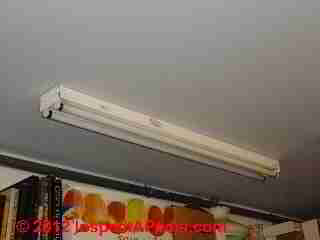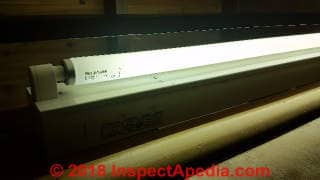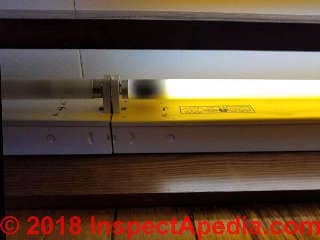 Flickering Fluorescent Light Causes / Cures
Flickering Fluorescent Light Causes / Cures
Diagnose & fix flickering fluorescent lights
- POST a QUESTION or COMMENT about building electrical systems, power, wiring, and flickering or dimming lights
To fix a flickering fluorescent light fixture we will be successful more quickly and at a lower cost if we take a few minutes to figure out what's wrong:
Is it the bulb, a connection, a loose wire, a bad starter, a bad ballast or transformer, or something else?
To sort out the causes and cures for flickering fluorescent lights we start by listing the causes of this annoying problem. After reviewing the causes of flickering lights we continue with the most-likely repair: diagnosing a bad bulb or lamp.
This article series explains how to diagnose the causes of flickering or dimming fluorescent light fixtures in buildings.
Watch out: flickering or dimming lights might indicate a dangerous condition risking a building fire or an electrical shock. If the simple bulb or starter repairs we describe here don't cure the flickering, switch off the bad-acting light fixture, leave it off, circuit and ask for help from a licensed electrician.
InspectAPedia tolerates no conflicts of interest. We have no relationship with advertisers, products, or services discussed at this website.
- Daniel Friedman, Publisher/Editor/Author - See WHO ARE WE?
Causes of Flickering Fluorescent Light Fixture
 Properly-functioning fluorescent lights should not produce a flickering that is noticeable. Standards for ballasts typically state:
Properly-functioning fluorescent lights should not produce a flickering that is noticeable. Standards for ballasts typically state:
Ballasts shall operate lamps with no visible flicker (<3% flicker index).
Traditional fluorescent lamps using a magnetic (old style) ballast may produce a high-frequency flickering that is sometimes barely noticeable. Fluorescents using a newer electronic ballast should will never show visible flickering unless there is another problem present.
More noticeable fluorescent lamp flickering occurs at the end of the fluorescent lamp's life and is a sign that the lamp (bulb) is ready for replacement.
However there are other sources of abnormal flickering fluorescent light fixtures that mean repairs are needed.
Common causes of flickering fluorescent light fixtures
- Bad electrical contact - between the pins at the end of the fluorescent tube and the metal contacts or clips inside of the tube socket at each end.
A fluorescent bulb that has not been properly seated into its contacts at both ends is, in my experience, one of the most-frequent causes of flickering or poorly-operating lamps.
Before even thinking about installing a new bulb, try rotating the tube back and forth 45 degrees in its socket to see if improved contact stops the flickering.
Watch out: take care not to use too much force nor to break the bulb as doing so exposes you to dangerous glass fragments and mercury dust and vapor.
- A bad fluorescent light bulb - notice dark or black burn marks near the ends of the tube - an indicator of age and possibly that the tube is at end of life. try replacing the bulb with a known-good one;
Details are at DIAGNOSE a BAD FLUORESCENT LAMP / BULB
Also see REPLACE a FLUORESCENT LAMP / BULB
If you have to dispose of a defective fluorescent bulb, or if despite our warnings above you do break a fluorescent bulb, you will find cleanup instructions
at FLUORESCENT LIGHT FIXTURE BULB / BALLAST DISPOSAL.
- A bad starter in the fixture - try replacing the starter.
Details are at FLUORESCENT LIGHT STARTER REPLACEMENT - A bad ballast in the fixture. Replacing a bad magnetic ballast with an electronic ballast can remove problems of flickering fluorescent light and will lower the operating cost of the fixture.
Details are at FLUORESCENT LIGHT TRANSFORMER / BALLAST REPLACEMENT
Less common causes of problems with fluorescent lights
- A bad bulb connector-socket: damaged, loose, or missing connectors in the clip-type socket into which the fluorescent bulb pins are inserted.
See FLUORESCENT LAMP CONNECTOR / SOCKET REPLACEMENT - Bad bulb connector: loose or damaged pins in the ends of the fluorescent light bulb (lamp) itself (uncommon) - you'll discover this by inspecting the pins on the end of the lamp: if a pin is bent, loose, or broken, replace the bulb.
Don't try to straighten a severely-bent pin: the risk is that you'll break the bulb or render its contacts and electrodes unsafe.
See REPLACE a FLUORESCENT LAMP / BULB - Bad wiring or switch: a loose or bad electrical wire connection or splice in the light switch or in the circuit supplying power to the light fixture.
An electrician will check wiring connections and splices and perhaps trace the circuit for a loose connector upstream.
See LIGHT SWITCH WIRING DETAILS - Unsafe electrical circuit breaker or unsafe electrical wire: some brands of circuit breaker may cause flickering lights or may fail to turn off in response to an over-current or short circuit, and may even fail to turn off internally when the toggle is switched to the OFF position.
Examples are at CIRCUIT BREAKER FAILURE RATES
Aluminum branch circuit wiring, found in some older homes wired in North America in the 1970's can overheat enough to start a fire without ever tripping a circuit breaker. Flickering lights can be a symptom of this problem developing IF your home uses aluminum wire.
Details are at ALUMINUM WIRING HAZARDS & REPAIRS - home - Voltage variations - or "voltage flickering" traced to the electrical power source.
Research on Flickering Fluorescent Lighting
- Sun, J., D. Czarkowski, and Z. Zabar. "Voltage flicker mitigation using PWM-based distribution STATCOM." In Power Engineering Society Summer Meeting, 2002 IEEE, vol. 1, pp. 616-621. IEEE, 2002.
- Veitch, Jennifer A., and Shelley L. McColl. "Modulation of fluorescent light: Flicker rate and light source effects on visual performance and visual comfort." Lighting Research and technology 27, no. 4 (1995): 243-256.
- Wilkins, A. J., I. Nimmo-Smith, A. I. Slater, and L. Bedocs. "Fluorescent lighting, headaches and eyestrain." Lighting Research and Technology 21, no. 1 (1989): 11-18.
- Winterbottom, Mark, and Arnold Wilkins. "Lighting and discomfort in the classroom." Journal of Environmental Psychology 29, no. 1 (2009): 63-75.
- Zweers, T., L. Preller, B. Brunekreef, and J. S. M. Boleij. "Health and indoor climate complaints of 7043 office workers in 61 buildings in the Netherlands." Indoor Air 2, no. 3 (1992): 127-136.
...
Continue reading at DIAGNOSE a BAD FLUORESCENT LAMP / BULB or select a topic from the closely-related articles below, or see the complete ARTICLE INDEX.
Or see these
Recommended Articles
- DIRECTORY OF ELECTRICIANS
- ELECTRIC POWER LOSS / FLICKERING LIGHTS - home
- FLICKERING LIGHTS, LOST NEUTRAL
- FLUORESCENT LIGHTING GUIDE INDOORS for Indoors and Guide to Using Compact Fluorescent Lights
- FLUORESCENT LIGHTS COMPACT INDOOR
- FLUORESCENT LIGHT REPAIRS
- HOW FLUORESCENT LIGHTS WORK
- ELECTRIC POWER LOSS / FLICKERING LIGHTS
- DIAGNOSE a BAD FLUORESCENT LAMP / BULB
- REPLACE a FLUORESCENT LAMP / BULB
- FLUORESCENT LIGHT BALLAST TYPES
- FLUORESCENT LIGHT BULB CODES & TYPES
- FLUORESCENT LIGHT BULB PHOTOS
- FLUORESCENT LIGHT BULB COLOR TEMPERATURE
- FLUORESCENT LIGHT FLICKERING CAUSES
- FLUORESCENT LIGHT FLICKERING CAUSES
- FLUORESCENT LIGHT STARTER REPLACEMENT
- FLUORESCENT LIGHT TRANSFORMER / BALLAST REPLACEMENT
- FLUORESCENT LIGHT TRANSFORMER / BALLAST TYPES
- FLUORESENT BULB SOCKET TYPES
- FLUORESCENT LAMP CONNECTOR / SOCKET REPLACEMENT
- FLUORESCENT LIGHT FIXTURE BULB / BALLAST DISPOSAL
- FLUORESCENT LAMP INSTRUCTIONS, PARTS, REPLACEMENTS
- FLUORESCENT vs INCANDESCENT BULBS
- MOBILE HOME ELECTRICAL - FLICKERING LIGHTS
- MOBILE HOME ELECTRICAL GFCI DIAGNOSIS
- MOBILE HOME ELECTRICAL POWER LOST
Suggested citation for this web page
FLUORESCENT LIGHT FLICKERING CAUSES at InspectApedia.com - online encyclopedia of building & environmental inspection, testing, diagnosis, repair, & problem prevention advice.
Or see this
INDEX to RELATED ARTICLES: ARTICLE INDEX to ELECTRICAL INSPECTION & TESTING
Or use the SEARCH BOX found below to Ask a Question or Search InspectApedia
Ask a Question or Search InspectApedia
Try the search box just below, or if you prefer, post a question or comment in the Comments box below and we will respond promptly.
Search the InspectApedia website
Note: appearance of your Comment below may be delayed: if your comment contains an image, photograph, web link, or text that looks to the software as if it might be a web link, your posting will appear after it has been approved by a moderator. Apologies for the delay.
Only one image can be added per comment but you can post as many comments, and therefore images, as you like.
You will not receive a notification when a response to your question has been posted.
Please bookmark this page to make it easy for you to check back for our response.
IF above you see "Comment Form is loading comments..." then COMMENT BOX - countable.ca / bawkbox.com IS NOT WORKING.
In any case you are welcome to send an email directly to us at InspectApedia.com at editor@inspectApedia.com
We'll reply to you directly. Please help us help you by noting, in your email, the URL of the InspectApedia page where you wanted to comment.
Citations & References
In addition to any citations in the article above, a full list is available on request.
- Our recommended books about building & mechanical systems design, inspection, problem diagnosis, and repair, and about indoor environment and IAQ testing, diagnosis, and cleanup are at the InspectAPedia Bookstore. Also see our Book Reviews - InspectAPedia.
- In addition to citations & references found in this article, see the research citations given at the end of the related articles found at our suggested
CONTINUE READING or RECOMMENDED ARTICLES.
- Carson, Dunlop & Associates Ltd., 120 Carlton Street Suite 407, Toronto ON M5A 4K2. Tel: (416) 964-9415 1-800-268-7070 Email: info@carsondunlop.com. Alan Carson is a past president of ASHI, the American Society of Home Inspectors.
Thanks to Alan Carson and Bob Dunlop, for permission for InspectAPedia to use text excerpts from The HOME REFERENCE BOOK - the Encyclopedia of Homes and to use illustrations from The ILLUSTRATED HOME .
Carson Dunlop Associates provides extensive home inspection education and report writing material. In gratitude we provide links to tsome Carson Dunlop Associates products and services.


